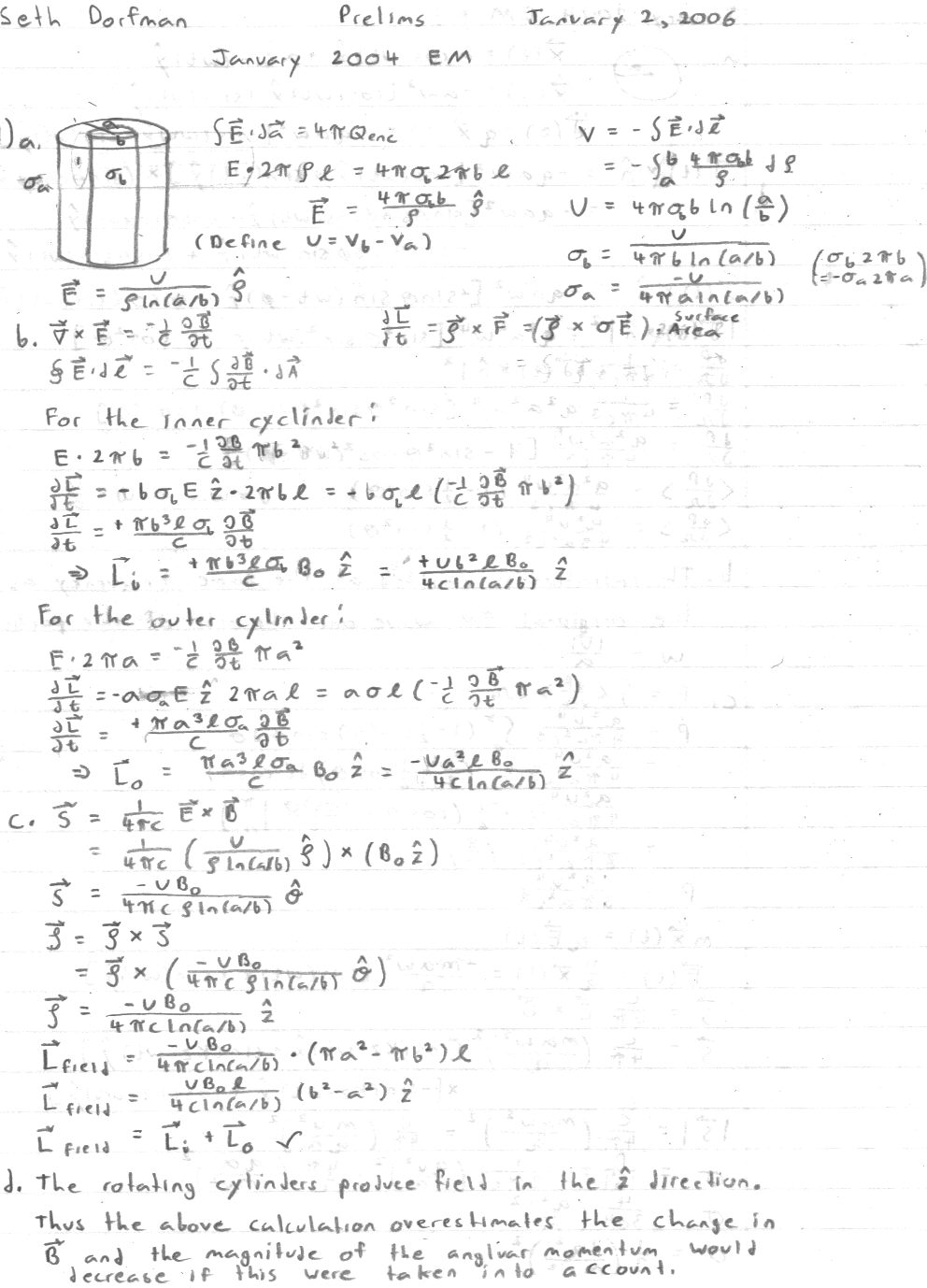EM J04 1
From QED
Consider a long cylindrical capacitor, which consists
of two metallic concentric cylinders of length l. The
radii of the cylinders are a (outer) and b (inner),  .
The axes of the two cylinders coincides with z-axis. As
an added bonus the cylinders are free to rotate about
the z-axis independently from each other and without
friction. The voltage between the two conductors is U.
Originally, at time t=0 there is also magnetic field
.
The axes of the two cylinders coincides with z-axis. As
an added bonus the cylinders are free to rotate about
the z-axis independently from each other and without
friction. The voltage between the two conductors is U.
Originally, at time t=0 there is also magnetic field  in z-direction.
in z-direction.
a. Determine charges on each of the cylinders at t=0
and the electric field  . (magnitude and direction), in
the volume between teh cylinders as functions of the
distance ρ from the axis. As in all parts of this exam,
either MKSA or Gaussian units may be employed.
. (magnitude and direction), in
the volume between teh cylinders as functions of the
distance ρ from the axis. As in all parts of this exam,
either MKSA or Gaussian units may be employed.
b. The magnetic field is slowly reduced, remaining
parallel to the z-axis, until it vanishes at some
moment of time, t0 . This causes the two cylinders to
start rotating. Use Faraday's law to determine the
angular momenta,  of each of them after the
magnetic field was reduced to zero. You may ignore the
magnetic field produced by the rotation of the
conductors. Also ignore any fringing of the fields at
the ends of the cylinders.
of each of them after the
magnetic field was reduced to zero. You may ignore the
magnetic field produced by the rotation of the
conductors. Also ignore any fringing of the fields at
the ends of the cylinders.
c. Recall that the electromagnetic fields contain a
momentum density,  (Gaussian units). Taking this fact
into account evaluate the angular momentum (magnitude
and direction) contained in the electromagnetic field
in teh initial configuration. Compare it with the total
angular momentum of the capacitor in the final configuration.
(Gaussian units). Taking this fact
into account evaluate the angular momentum (magnitude
and direction) contained in the electromagnetic field
in teh initial configuration. Compare it with the total
angular momentum of the capacitor in the final configuration.
d. How will the result for the angular momentum of the two cylinders change (increase, decrease or remain the same) if the magnetic field of the rotating cylinders were taken into account?
Solution 1
Solution 2
We use a gaussian integral around the inner cylinder:

The potential difference is given by:

Solving for σi:

The potential is given by:
So that the charge on the outer cylinder is given by:

We can integrate the charge densities to get the total charge:
<math>Q_{i}=2\pi bl\sigma_{i}=l\frac{U}{2\ln\left(a/b\right)}</math>

And the electric field is given by:

The Faraday's Law gives:

So that for the inner cylinder:

The torque will be:

So that the induced angular momentum will be:

For the outer cylinder:

So that:

And the total angular momentum is:

The field momentum is given by the Poynting Vector:

So that its angular momentum is:

where the integral over z and θ is already done. Integrating over r:

The momentum would decrease, as the cylinders turn to
oppose the change in  in the
same direction as before. This field would have angular
momentum in the same direction, so that the cylinders
themselves would have less angular momentum.
in the
same direction as before. This field would have angular
momentum in the same direction, so that the cylinders
themselves would have less angular momentum.
This page was recovered in October 2009 from the Plasmagicians page on Prelim_J04_EM1 dated 23:32, 3 January 2006.













